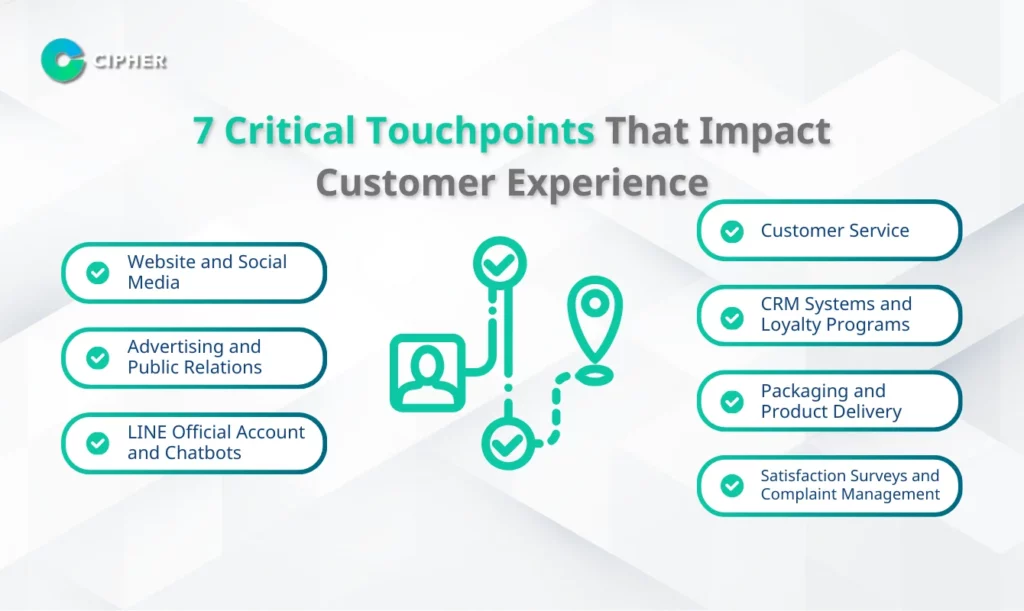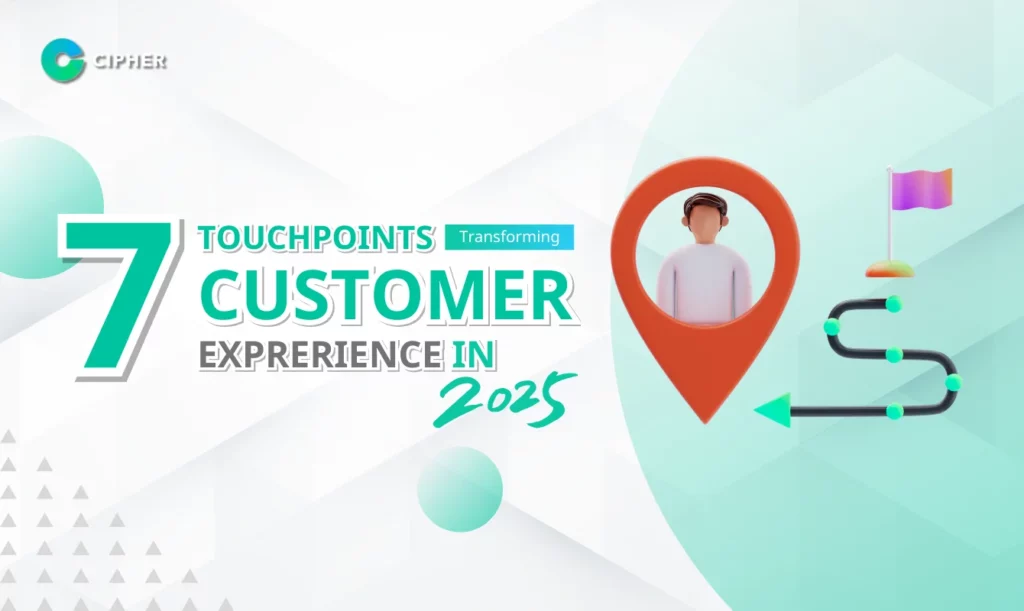Table of Contents
In today’s digital marketing landscape, creating exceptional customer experiences (Customer Experience or CX for short) has become a vital strategy for sustainable business growth. Touchpoints—the various points of interaction between your brand and customers—directly influence these experiences. This article explores the 7 critical touchpoints that impact customer experience and provides effective management techniques to optimize them.
What Is a Touchpoint and Why Is It Important for Your Business?

A touchpoint is any channel through which customers can interact with your brand or business, whether through communication or service utilization. These interactions occur throughout the customer journey—from initial discovery and consideration to purchase decision and post-purchase experience.
The importance of touchpoints lies not in their quantity but in their quality and ability to address customer needs at each stage. Even if you offer excellent products or services, a single negative touchpoint experience can tarnish your brand’s overall image. This is why Customer Experience Marketing, working in conjunction with the right marketing mix, has become a crucial strategy for many businesses.
The Difference Between Touchpoints and Customer Journey
Many people confuse touchpoints with the customer journey, as both involve interactions between customers and brands. However, there are significant differences:
- Touchpoints are specific interaction channels or points of contact where customers engage with your brand, serving as the frontline for creating impressions and positive experiences.
- Customer Journey maps the entire path customers take, from being unaware of your brand to becoming interested, making a decision, purchasing, and eventually returning to buy again and recommend your brand to others. It’s like a map that helps understand all customer stages and experiences.
Both touchpoints and customer journey must work together in balance, with neither one dominating, to effectively collect data and optimize the customer experience.
7 Critical Touchpoints That Impact Customer Experience

1. Website and Social Media
Websites and social media platforms are vital windows for businesses in the digital era and are often among the first touchpoints customers encounter when searching for product or service information. Designing an attractive website and creating engaging social media content that is easy to understand and meets customer needs will create a positive first impression. This represents one of the most important customer experience examples in the digital age.
Tips: Design a user-friendly website with comprehensive information and fast loading times. Create valuable content that addresses your target audience’s needs, and consistently respond to comments and messages on social media in a timely manner through effective social media management.
2. Advertising and Public Relations
Both online and offline advertising are important touchpoints that help customers discover your brand. Creating advertisements that clearly communicate your brand’s selling points and values will attract customers’ interest and encourage them to learn more about your products or services.
Tips: Design creative advertisements that resonate with your target audience and clearly communicate your selling points. Choose advertising channels that align with your target audience’s behavior.
3. LINE Official Account and Chatbots
LINE Official Accounts and chatbots are touchpoints that enable customers to contact your brand directly and quickly. They help announce news, promotions, or answer customer questions 24/7, creating positive experiences and special feelings for customers.
Tips: Use LINE Official Accounts to send promotional messages that benefit customers, avoid sending too many messages, and configure chatbots to answer basic questions accurately and quickly.
4. Customer Service
Customer service before, during, and after sales is a crucial touchpoint for creating impressions and satisfaction. Knowledgeable staff with good communication skills and a passion for service will help create positive customer experiences. Many wonder what customer service actually entails beyond answering questions, which includes providing product and service recommendations, problem-solving, complaint management, and building good relationships with customers.
Tips: Train staff to have in-depth knowledge about products and services, develop good communication and problem-solving skills, and create a service culture that prioritizes customer satisfaction.
5. CRM Systems and Loyalty Programs
Customer Relationship Management (CRM) systems and loyalty programs are touchpoints that help retain existing customers and encourage repeat purchases. Collecting customer data and purchasing behavior helps you offer products or services that specifically meet each customer’s needs. Understanding CRM benefits is crucial for businesses looking to enhance their customer relationships.
Tips: Implement CRM systems to collect and analyze customer data, create loyalty programs with attractive rewards or privileges, and use personalized communication to impress customers.
6. Packaging and Product Delivery
Packaging and product delivery are important touchpoints for creating positive post-purchase impressions. Beautiful, sturdy, and environmentally friendly packaging, along with fast and accurate delivery, will enhance the customer experience.
Tips: Design packaging that reflects your brand identity, pay attention to small details like thank-you notes to customers, and choose reliable delivery services.
7. Satisfaction Surveys and Complaint Management
Satisfaction surveys and complaint management are touchpoints that help you understand customer needs and expectations, allowing you to improve and develop products or services to better meet customer requirements.
Tips: Create concise and easy-to-understand satisfaction surveys, handle complaints quickly and professionally, and continuously improve based on customer feedback.
What Makes a Good Touchpoint?
Creating good touchpoints isn’t just about covering all channels but about truly delivering positive customer experiences. Designing quality touchpoints starts with understanding that good touchpoints should be:
- Simple and Uncomplicated – Customers can easily understand and use them without encountering overly complex steps
- Contextually Appropriate – Responds to customer needs at each stage of the customer journey
- Connected to Needs – Relevant and responsive to customer requirements and expectations
- Valuable and Meaningful – Clearly presents value and benefits to customers
- Attractive and Impressive – Creates positive feelings that make customers want to return
CX encompasses all experiences customers have with your business, from first brand awareness to becoming regular customers. Therefore, the experience at each touchpoint must be meticulously designed to create maximum impact.
Touchpoint Stages Along the Customer Journey
1. Awareness Touchpoints
At this stage, customers don’t yet know your brand, so you need to push your brand toward them, introducing your products or services until they become interested. Touchpoints in this stage include:
- Online and offline advertising
- Social media
- Content marketing
- Website
- Events or exhibitions
2. Consideration Touchpoints
Once customers know your brand, they begin considering whether your products or services meet their needs. Touchpoints at this stage provide additional information and help with decision-making:
- Reviews and customer testimonials
- Website (detailed product or service information)
- Educational blogs or articles
- Product demonstrations or service trials
- Sales staff or consultants
3. Decision Touchpoints
When customers are in the purchase decision stage, touchpoints here help build confidence and make purchasing decisions easier:
- Convenient and secure payment systems
- Promotions and discounts
- Return policies and warranties
- Advisory sales staff
- Easy-to-use reservation or ordering systems
4. Retention Touchpoints
After customers have purchased products or used services, touchpoints at this stage help maintain relationships and encourage repeat purchases:
- Thank you emails or messages
- After-sales service
- Problem-solving and support
- Loyalty programs or membership benefits
- Updates on news and new promotions
How to Measure Touchpoint Effectiveness
Measuring touchpoint performance is crucial to understanding which touchpoints are effective and which need improvement. You can use these metrics for evaluation:
- Engagement Rate – Measured by likes, comments, shares on social media
- Click-Through Rate (CTR) – Measured by clicks compared to impressions
- Conversion Rate – Measured by the number of buyers compared to visitors
- Customer Satisfaction Score (CSAT) – Measured through satisfaction surveys
- Net Promoter Score (NPS) – Measures the likelihood that customers will recommend your brand to others
This data helps you understand which products or services interest customers most and helps improve your brand to better meet customer needs.
Continuous Improvement and Development of Touchpoints
Touchpoints aren’t created once and forgotten—they require continuous improvement and development as customer behaviors and technologies constantly change. Therefore, you should:
- Regularly monitor customer behavior – Study how customers change their behavior or needs
- Collect customer feedback – Listen to opinions and suggestions from customers for improvements
- Test new touchpoints – Experiment with new touchpoints or technologies to increase efficiency
- Regularly analyze performance – Check if existing touchpoints still effectively meet customer needs
- Learn from competitors – Study how competitors use touchpoints and adapt strategies for your business
Touchpoint Management Services from Cipher
At Cipher, we specialize in comprehensive management of all 7 touchpoints with a team of digital marketing experts ready to elevate your Customer Experience Marketing. Our services include:
- Customer Journey analysis and design – Helping you understand the customer journey and design appropriate touchpoints
- Website and application development – Creating user-friendly websites and applications that meet customer needs, including enterprise CMS solutions for larger organizations
- Social media management – Managing and developing social media content to create customer engagement
- LINE Official Account and chatbot strategy – Designing and developing communication systems through LINE OA and chatbots that increase customer service efficiency
- CRM system and loyalty program development – Helping create and manage CRM systems and loyalty programs that retain customers and stimulate repeat purchases
- Touchpoint analysis and improvement – Using modern tools and technologies to analyze and improve touchpoint efficiency
- Customer service team training – Developing skills and knowledge for your customer service team to create outstanding customer experiences
Conclusion
Good touchpoints are key to creating impressive customer experiences, directly affecting business success in attracting new customers, increasing sales opportunities, building brand loyalty, and generating referrals.
In today’s highly competitive digital age, efficient touchpoint management isn’t optional—it’s essential for every business. Remember that touchpoints must be continuously developed to align with changing customer needs.
Investing in touchpoint development today will help build a foundation for long-term success and competitive advantage for your business.





